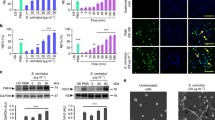Abstract
Investigation of the antiinflammatory properties of bee venom demonstrates that it inhibits production of superoxide anion by human neutrophils in a potent, selective, nontoxic, dose-dependent fashion, both pre- and poststimulation by particulale and soluble activators of the neutrophil oxidative metabolism burst. The effect is not due to receptor competition, superoxide dismutase, and/or catalase activity, scavenging, or indicator media effects. These findings may explain the antiinflammatory effects of whole bee venom in experimental systems, its widespread use in folk medicine, and lead to the development of potent, new antiinflammatory substances for therapeutic use in man.
Similar content being viewed by others
References
Beck, B. 1935. Bee Venom Therapy. D. Appleton-Century Company, New York.
Yoirish, N. 1977. The Curative Properties of Honey and Bee Venom. New Glide Publications, San Fransisco.
Billingham, M. E. J., J. Morley, andJ. M. Hansom. 1973. An antiinflammatory peptide from bee venom.Nature 245:163–164.
Chang, Y. H., andM. L. Bliven. 1979. Antiarthritic effect of bee venom.Agents Actions 9:205–211.
Lorenzetti, O. J., B. Fortenberry, andE. Busby. 1972. Influence of bee venom in the adjuvant induced arthritic rat model.Res. Commun. Chem. Pathol Pharmacol. 4:352–399.
Lockshin, M. D. 1981. Special article. The unproven remedies committee.Arthritis Rheum. 24:1188–1190.
McCord, J. M., K, Wong, andS. H. Stokes. 1980. Superoxide and inflammation: A mechanism for the antiinflammatory activity of superoxide dismutase.Acta Physiol. Scand. Suppl. 494:25–30.
McCord, J. M., andK. Wong. 1979. Phagocyte produced free radicals: Roles in cytotoxicity and inflammation.In Oxygen Free Radicals and Tissue Damage (Ciba Found Symp 65) D. W. Fitzsimmons, editor. Elsevier, Excerpta Medica, North Holland, Amsterdam. 343–369.
Ferrante, A., andY. H. Thong. 1980. Optimal conditions for simultaneous purification of mononuclear and polymorphonuclear leukocytes from human peripheral blood by Hypaque-Ficoll method.J. Immunol. Methods 36:109–117.
Benton. A. W., R. A. Morse, andStewart, J. D. 1963. Venom collection from honey bees.Science 142:228–230.
Cohen, H. J., andM. E. Chovaniec. 1978. Superoxide generation by digitonin stimulated guinea pig granulocytes. A basis for a continuous assay monitoring superoxide production and for the study of the activation of the generating system.J. Clin. Invest. 61:1081–1087.
McPhail, L. C., P. M. Henson, andR. B. Johnston. 1981. Respiratory burst enzyme in human neutrophils: Evidence for multiple mechanisms of activation.J. Clin. Invest. 67:710–716.
Pick. E., andY. Keisari. 1980. A simple colorimetric method for the measurement of hydrogen peroxide produced by cells in culture.J. Immunol. Methods 38:161–170.
Fridovich, I. 1970. Quantitative aspects of the production of superoxide anion radical by milk xanthine oxidase.J. Biol. Chem. 215:4053–4057.
Henson, P. M., andZ. G. Oades. 1975, Stimulation of human neutrophils by soluble and insoluble immunoglobulin aggregates.J. Clin. Invest. 56:1053–1061.
McPhail, L. C., andR. Snyderman. 1983. Activation of the respiratory burst enzyme in human polymorphonuclear leucocytes by chemoattractants and other soluble stimuli. J.Clin. Invest. 72:192–200.
Barbior, B. M., J. T. Cusrnutte, andB. J. McMurrich. 1976. The paniculate superoxide-forming system from human neutrophils. Properties of the system and further evidence supporting its participation in the respiratory burst.J. Clin. Invest. 58:989–996.
Simchowitz, L., I. Spilberg, andJ. P. Atkinson. 1980. Superoxide generation and granule enzyme release induced by ionophore A23187: Studies on the early events of neutrophil activation.J. Lab. Clin. Med. 96:408–424.
Takeshige, K., andS. Minakami. 1981. Involvement of calmodulin in phagocytic respiratory burst of leukocytes.Biochem. Biophys. Res. Commun. 99:484–490.
Smith, R. J., B. J. Bowman, andS. S. Idem. 1981. Effects of trifluoperazine on human neutrophil function.Immunology 44:677–684.
Smolen, J. E., andG. Weissmann. 1981. The roles of extracellular and intracellular calcium in lysosomal enzyme release and superoxide anion generation by human polymorphonuclear leucocytes.Biochim. Biophys. Acta 677:512–520.
Jones, H. P., G. Chai, andW. F. Petrone. 1982. Calmodulin-dependent stimulation of the NADPH oxidase of human neutrophils.Biochim. Biophys. Acta 714:152–156.
Comte, M., Y. Maulet, andJ. A. Cox. 1983. Ca+-dependent high-affinity complex formation between calmodulin and melittin.Biochem. J. 209:269–272.
Malencik, D. A., andS. R. Anderson. 1983. High affinity binding of the mastoparans by calmodulin.Biochem. Biophys. Res. Commun. 114:50–56.
Habermann, E. Personal communication.
Mori, T., Y. Takai, andR. Minakuchi. 1980. Inhibitory action of chlorpromazine, dibucaine and other phospholipid interacting drugs on calcium-activated phospholipid-dependent protein kinase.J. Biol. Chem. 255:8378–8380.
Katoh, N. R. L. Raynor, andB. C. Wise. 1982. Inhibition by melittin of phospholipid-sensitive and calmodulin-sensitive Ca2+-dependent protein kinases.Biochem. J. 202:217–224.
Castagna, M., Y. Takai, andK. Kaibuchi. 1982. Direct activation of calcium activated phospholipid-dependent protein kinase by tumor producing phorbol esters.J. Biol. Chem. 257:7847–7851.
Author information
Authors and Affiliations
Additional information
Supported by grants from Medical Research Council of Canada (No. 6431), Arthritis Society of Canada (No. 5-261-83), Arthritis Foundation of New Zealand, and Rose Hetlaby Trust.
Rights and permissions
About this article
Cite this article
Somerfield, S.D., Stach, JL., Mraz, C. et al. Bee venom inhibits superoxide production by human neutrophils. Inflammation 8, 385–391 (1984). https://doi.org/10.1007/BF00918214
Issue Date:
DOI: https://doi.org/10.1007/BF00918214




